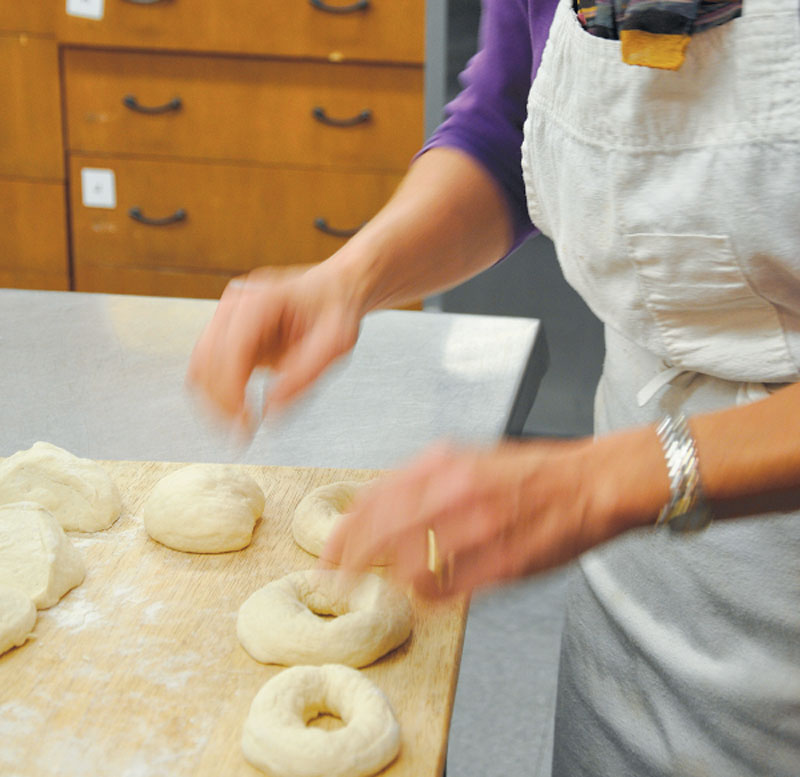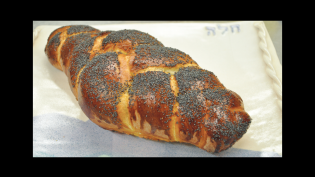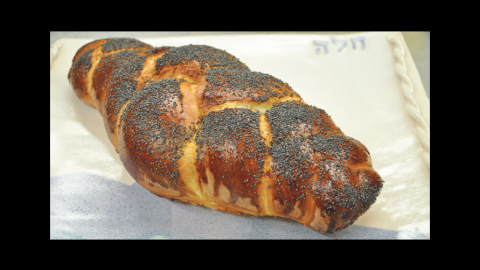Jewish Bread on the Cape? Do It Yourself!
I was waiting in line at a deli in New York City when the man behind the counter asked the customer in front of me if he wanted his bagel toasted. “Toast?” he cried, in a thick New York accent. “What’s to toast? Is it fresh?” The idea of toasting a bagel to make it crusty was appalling to this particular aficionado. Bagels that are freshly baked, as they are expected to be in New York, are toothy without toasting. But what about bagels outside New York, like here on Cape Cod? Well, let’s just say that most of us order them toasted.
Jewish breads have become part of mainstream American food culture, with bagels being by far the most commonly consumed. But rye and pumpernickel breads, challah and bialys are close behind. Dana Tillman, of Dana’s Kitchen restaurant in Falmouth, described to me the Jewish bakeries of her childhood in a Detroit suburb. “You walk in and you have a million breads. And all the little butter cookies with the sprinkles that they sell by the pound, at least 15 different kinds. And the strudels and babkas. Those bakeries are few and far between. There may be only a handful left.”
For foodies, the thrill is often in the hunt for a great meal. But no matter how hard you look, a real Jewish bakery like the one of Tillman’s childhood is not to be found on Cape Cod. The closest one is in Boston. So, in this corner of the world, if you can’t find what you crave, what do you do? You just have to make it yourself.
Pamela Rothstein is the Director of Lifelong Learning at the Falmouth Jewish Congregation. She has been helping members of that community make their own Jewish specialties for the past 14 years, and her passion is bread. “A lot of people are scared of bread baking,” admits Rothstein. “They are sort of intimidated by yeast and don’t understand it. But generally, yeast is very forgiving.”
Last year the Falmouth Jewish Congregation published the cookbook FJC Cooks!, and in it you will find Rothstein’s recipe for her famous challah bread. Challah is an egg bread with a shiny braided crust and yellowish color that brightens up any meal. Eaten weekly as the centerpiece of the Sabbath, or Shabbat, meal, challah may be the most important of all Jewish breads.
Rothstein bakes challah every Friday for her family. The routine punctuates her week and provides a much-needed pause in her busy life. “Making any homemade food slows you down because it slows the other aspects of your life. The Jewish Sabbath imitates the story of creation, where you have creation for six days and on the seventh day God rests. The Sabbath is meant to slow you down, and making challah for Sabbath gets you in the mode.”
Challah is available at many Cape Cod grocery stores and bakeries. Stop & Shop carries it, as well as Trader Joe’s and some smaller markets—and not just on Fridays. It’s a versatile and tasty bread that can be served on its own or incorporated into other dishes. You can dress it up with raisins or poppy seeds, and it is killer with peanut butter and jelly. At Dana’s Kitchen there is challah on the sandwich menu every day. Leftovers get turned into croutons or bread pudding. Although you can find it in stores, making your own challah tastes better than buying it. Store-bought challah is “pretty bland,” warns Tillman. “It doesn’t come up to par with what we do or with what I grew up with.”
That’s one reason why the five- and six-year olds at the Falmouth Jewish Congregation are learning to make challah in the weekend religious school. Instructor Sheri O’Malley makes the dough at home and brings it in to teach the children how to form a traditional braided loaf. Because they look like intertwined arms, the challah braids symbolize coming together and unity. Lisa Abbo, mother of five-year old Evey, was helping out on a recent Sunday as the kids kneaded their dough. “I think a lot of people today were never taught. It’s sad. I think that something as simple as bread everyone should know how to do.” With one adult helping each child, the children work carefully to braid their dough. It is tricky work for little fingers, but all the children end up with a very passable loaf. Next they paint the top with egg yolk, and it’s ready to bake. Twenty minutes later children and parent helpers alike are enjoying fresh challah, right from the oven. “It’s nice for them to see where everything comes from,” remarked O’Malley as she watches her students gobble down the warm treat. “On the Sabbath it’s nice to take that time with family and make dinner—and make challah.”
As the Sunday school kids are learning, challah is easy to make at home. “With bread the ingredients are simple. The secret is all in the handling,” confides Rothstein. She advises home bakers to make sure the dough is braided tightly and the ends secured. Rothstein also applies her egg glaze twice, with a few minutes between applications to let the first layer dry. This makes the glaze extra shiny—and extra pretty.
Once you have your homemade challah down, you can turn your attention to the rock star of Jewish bread—the bagel. Bagels came to this country from Europe with the Jewish immigrants who arrived between 1880 and 1924. Weighing in at less than three ounces, the original bagels were smaller and thinner than today’s puffed up version. Bagels were made by hand in four-man teams: two shapers, one boiler and one baker. The teams worked overnight in cramped cellars, and could crank out over 6000 bagels per shift. In 1907 there were over 300 bagel bakeries in New York City. Demand was high, but the customers were still primarily Jewish. In 1956 The New York Times disparaged the bagel as a “doughnut with rigor mortis,” and it remained a niche item.
It was Murray Lender, the son of a Connecticut bagel baker, who broadened the appeal to non-Jews by introducing the frozen pre-sliced bagel to grocery chains in the early 1960s. When Lender started using the newly invented commercial bagel-making machine in 1963, the bagel entered the modern era. But mechanization stripped the bagel of its original character. The machine eliminated the need for hand rolling. A 30-second high-pressure steam blast eventually replaced the slow water boil. Sugar replaced malt powder, and bagels increased in size to four to five ounces.
Bagels are now so mainstream that some people may not even realize they are a Jewish item. You can find bagels pretty much anywhere you go—on the Cape and all over the country. But today’s bagel would be almost unrecognizable to its fans even fifty years ago. “Bagels have evolved into something that resembles but is far from what they once were,” says Rothstein. “They’ve been supersized and that takes away from the texture, which should be chewy to the point that your jaw begins to hurt!”
JoMama’s New York Bagels and Coffeehouse, with locations in Brewster and Orleans, may have the most authentic bagels on Cape Cod. JoMama’s stays true to the bagel’s New York roots by importing them hand-rolled and pre-boiled from Davidovitch Bakery in Queens. “It’s something about the New York water,” says manager Jessica Drown from the Brewster store. “In summer we get tons of people coming in here saying ‘You have the only good bagel on Cape Cod!’” JoMama’s bakes 250 bagels a day and the result really does taste different from your average bagel; more like a true New York bagel that requires some mandibular stamina to consume. They are still quite large—mine weighed 4.5 ounces—but the chewiness made me realize that there is indeed room for improvement in what we have come to expect in a bagel.
Then I went to Vers Restaurant and Patisserie in Chatham. Stephen Jones is the pastry chef at this newly-opened mecca for local artisanal foods. Jones makes his own bagels to accompany the lox and cream cheese on the pâtisserie menu. The bagels are small—almost cute—and perfectly chewy. They are heaven. Of course, Jones, who has worked at such places as the Bellagio in Las Vegas and the Four Seasons in Palo Alto and Santa Barbara, wouldn’t have it any other way. “That’s just what I do. I’m a pastry chef,“ deadpans Jones. “Everything we serve here is made in house. I wouldn’t go out and buy a bagel.”
Okay, that makes sense for a chef, but what about us average citizens in our home kitchens? I turned back to Pamela Rothstein at the Falmouth Jewish Congregation to see if I could make a bagel. She invited me to the congregation’s kitchen for a baking session. We were joined by FJC member Jane Altshuler of Mashpee, who, like Rothstein, believes in the superiority of homemade. “Food that you make yourself is always better than what you can get out,” declared Altshuler, as she and Rothstein walked me through the bagel-making process.
It really wasn’t that hard. Bagels have only five ingredients: flour, water, malt powder, salt and yeast. Because the dough is simple, we concentrated on the shape. A key part of its anatomy has disappeared from the modern bagel—the hole. Today, the center of most bagels looks more like a belly button than a hole. In the old days, boiling helped a bagel retain its shape. The hot water killed the yeast on the outside of the bagel, preventing further rising in the oven. The hole made the bagel easier to scoop from the boiling water. Most importantly, without a proper hole, the center crust of the bagel will not get crisp in the oven. Today, with most bagels made by commercial machines and flash-steamed instead of boiled, bagels have a developed a muffin top—like everybody else.
In the FJC kitchen we rolled a long strip of dough and pinched the ends together to make a ring. Once the ends were joined together, we rolled the pinch point a little to smooth it out. This is key, or else your bagel could break up in the boiling process and become a bagel stick. After a two-minute boil, we topped them with seeds, salt, cinnamon or nothing, and loaded them into a hot oven for 25 minutes. What came out of that oven was the best-tasting bagel I have ever had. Altshuler agreed. “You just can’t buy bread from a store that tastes this good. No way,” she exclaimed. “And then there is the thrill of eating something that you made yourself. People are impressed!” I know I am.
The last Jewish bread on my do-it-yourself list was a bialy. The bialy is a little more exotic than bagels and challah, and a little less known. It is a cousin of the bagel, kind of like a Danish roll with onion in the middle instead of fruit. Bialys were ubiquitous in the Jewish sections of Bialystock, Poland, before WWII wiped out the Jewish population there. Called “bialystocker kuchen”, they were eaten with every meal. Sometimes, they were the entire meal.
Immigrants brought bialys to this country at the same time as the bagel, but they never had much success outside of New York City. This is mostly because bialys don’t lend themselves to mechanization. They need to be hand shaped and “schmeared” with a dollop of chopped onion and poppy seed before baking. Another feature that makes finding a good bialy so elusive is their extremely short shelf life of about six hours. This means that while you can make do with a puffy bagel or frozen challah, you cannot fake a fresh bialy. If you can find them in the grocery stores, you will almost certainly be toasting them.
I gave bialys a try at home, using an authentic recipe from a popular course on bagel and bialy baking that Rothstein gave last June at the FJC. “They most of all loved eating fresh bialys,” remembers Rothstein. “One participant returned home and made them that very night for her husband. It’s just that little bit of onion and poppy seed that transforms that bread. It’s the magic of onions.”
My experience was magical as well. Bialys are more like a roll than a bagel and there is no boiling required. The most time consuming part of the process is the rising. My recipe required three rising sessions, so a slow Sunday was the best day to work bialy baking into my schedule. This bread, and all bread really, is definitely slow food. But it was worth the time and effort to watch my family gobble down fresh bialys—ones that I made.
So, whether it is a bialy or a bagel—or one of the many other fabulous Jewish breads that are out there—I am going to recommend taking a moment to slow down, do it yourself, and establish the best Jewish bakery on Cape Cod right in your own home kitchen.






